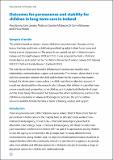Outcomes for permanence and stability for children in long-term care in Ireland
Date
2018Author
Roarty, Nora
Leinster, John
McGregor, Caroline
Devaney, Carmel
Moran, Lisa
Metadata
Show full item recordUsage
This item's downloads: 730 (view details)
Recommended Citation
Roarty, Nora, Leinster, John, McGregor, Caroline, Devaney, Carmel, & Moran, Lisa. (2018). Outcomes for permanence and stability for children in long-term care in Ireland. Foster, 5.
Published Version
Abstract
This article is based on research about children in long-term care. It focuses on the
factors that help and hinder a child being and feeling stable in their foster home and
having a sense of permanence. The research was carried out with children in care in
Galway and Donegal between 2008 and 2013. It was proposed by Tusla – Child and
Family Agency and carried out by the National University of Ireland, Galway (NUI Galway)
UNESCO Child and Family Research Centre (UCFRC).
The main factors that were found to infl uence permanence and stability were
relationships, communication, support and continuity. The research shows that it is not
only the connection between the child and the foster family or parent that matters.
Instead, the whole system surrounding the child must also be taken into account. A
model was developed from the research which showed that children in care often have
a more complicated system than other children, as it includes both the family of origin
and the foster family. This research has been used to inform and improve practice in the
children-in-care teams in Galway and Donegal. In particular, this article outlines
resources available to foster families in terms of training, services and support.


